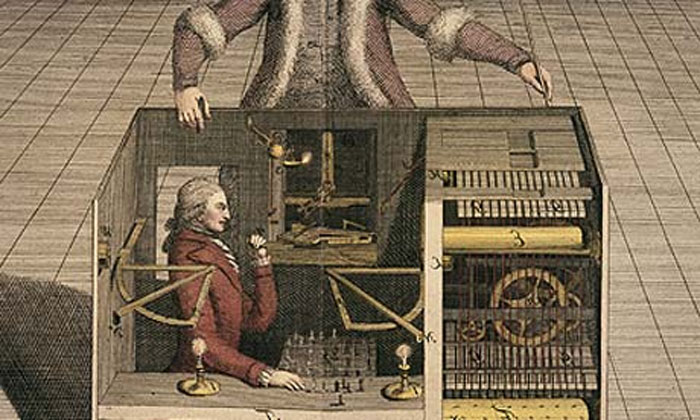This is the second of six posts about the present. Caveat lector.

“The explosion of the automaton’s popularity in the eighteenth and nineteenth centuries — with stories such as E. A. Hoffman’s “The Sandman” (1816) featuring automatons and subsequently provoking analyses by Jentsch and Freud — led to the automaton’s adoption by the surrealists, in part as a metaphorical stand-in for the destabilising forces of industrialisation.”
In the above quote — a wall text for Philippe Parreno’s The Writer, at the New Museum — you can replace “automaton” with “drone” and “industrialisation” with “the network” and still make sense. That’s what I’m doing anyway.
The most-cited automaton is Wolfgang von Kempelen’s Mechanical Turk of course, and inside the Mechanical Turk, there always was a person. Jacques François Mouret. Johann Baptist Allgaier. William Schlumberger. Hyacinthe Henri Boncourt. William Lewis. A generation’s best chess players condemned to spend their declining years locked in a box, pretending to be a machine. Indebted. Probably drunk. When the box was opened, the occupant would slide to one side, then the other, an array of clockwork sliding into place to conceal them at each turn. I think Gavin Turk’s impersonation of the machine is a cheap, delightful trick: forget controlling the machine; impersonate it. Fake it til you make it, like horse_ebooks, like A Ship Adrift.
A couple of months ago I saw some strange artefacts in the Henry Ford Museum, in Dearborn, MI. A skeuomorphic beam engine, for starters: a vast iron structure for transforming heat into motion, the beating heart of the industrial revolution, styled to look like a gothic cathedral. “Every technology goes through an adolescent phase,” explained the curator. “It starts as pure mechanism, then it becomes domesticated, then it gets ‘industrial designed’—made to look sleek and fast, mostly—and then it becomes banal, just a box.” The ‘retro’ look of the Novelty Iron Works engine belies the advanced nature of the mechanism. (The use of the word ‘novelty’ in the sense of ‘amusement’ dates only from 1901; before this, it really did mean New.)
Another artefact: a rebuilt Newcomen steam engine, which predates Watts’ invention. The Newcomen engine was expensive, and thus rarely employed except in places where it could dig its own fuel, at mine-heads. By 1796 Watt had tripled the efficiency of the engine, so it could be sold and more widely distributed. It thus became part of a networked system, of canals, or transportation. Not the first network, but a critical one. The Newcomen engine is unique and important because it is the first machine built upon non-renewable energies, a change in the “natural compact”. These lines are crossed so easily, on a long enough timeline.
A final artefact of design and the network: Robert Propst’s “Action Office” system for Herman Miller. The invention of the cubicle, symbol of all that is hellish about rote employment. But Propst intended the Action Office to be open, free-flowing, and reconfigurable by the user. Management “efficiency”, hardwired electronic equipment (technology designed without thought of context) and estate management (estrangement of workers from the tools of the job) meant cubicalism became fixed and overcrowded. A failure of context, still: an attempt to design the chair by considering it in a room, for sure, but ignorant of the invisible context of corporate and legal frameworks, of technologies.
Looking at the machines in the Henry Ford museum, you realise that “efficiency” is what happens when everything is systematised: it’s the evolution of the system. It’s also blind to the sources of inefficiencies, or, rather, all inefficiencies look the same. So a dirty bomb, or an earthquake, or a hurricane, have the same value in a logistics system. And this is why legitimate civil protests end up getting treated like terrorism.
The current peak evolution of the Chinese Room, of the Mechanical Turk – both von Kempelen’s box and Amazon’s behemoth – is found in the even more starkly applied organisation of Taskrabbit, the ultimate people-as-a-service, an engineer’s dream version of the network which allows one to skirt any number of labour laws or ethical issues.
You can’t “protest” against Taskrabbit, against Uber, against drones. The conditions of the conversation are binary: you’re either in, or you’re out. Ultracapitalism, ultrahistory, a complete system.
Taskrabbit, Uber, drones, high-frequency trading, austerity, and this: the natural endpoint of algorithmic capitalism. Cheap humans. Just-in-time people. A generation inside the machine, so drunk and indebted that it will be their lasting fame. An airbnb of the flesh. Impersonate the machine.
Each of these things is a result of tool use rather than collaboration, of unequal power relationships, of attempting to articulate an efficiency in the network. It’s an attempt to freeze the system, to declare it complete and contained, an automaton, but this is anti-network, and the paucity of its thinking is revealed by the network. The failure takes many forms, but it’s a contextual failure. You have to include the demon in the system, you have to include the man in the box.
The New Aesthetic has been repeatedly and roundly criticised for not stating itself clearly in a way that old frameworks, artistic and academic, may get their heads around; but also for romanticising “robots”, a fundamental misunderstanding of the difference between reifying the machine and attributing agency to the machine as paranoiac-critical method, as spatial analysis. There is no romanticisation here. Of course the gaze of the machine is our gaze too: this is what a literacy of the network attempts to articulate, this is what we are attempting to point at — from the inside.
Comments are closed. Feel free to email if you have something to say, or leave a trackback from your own site.